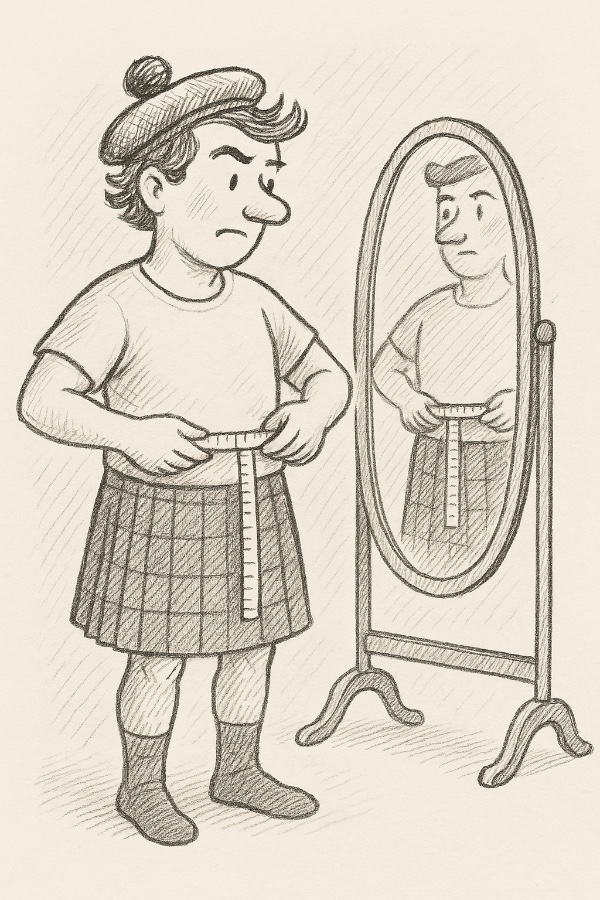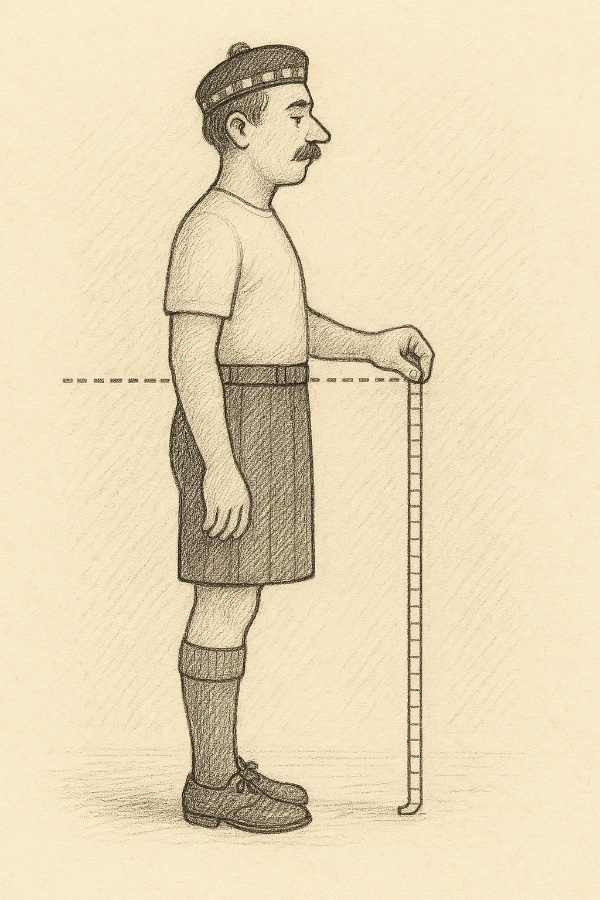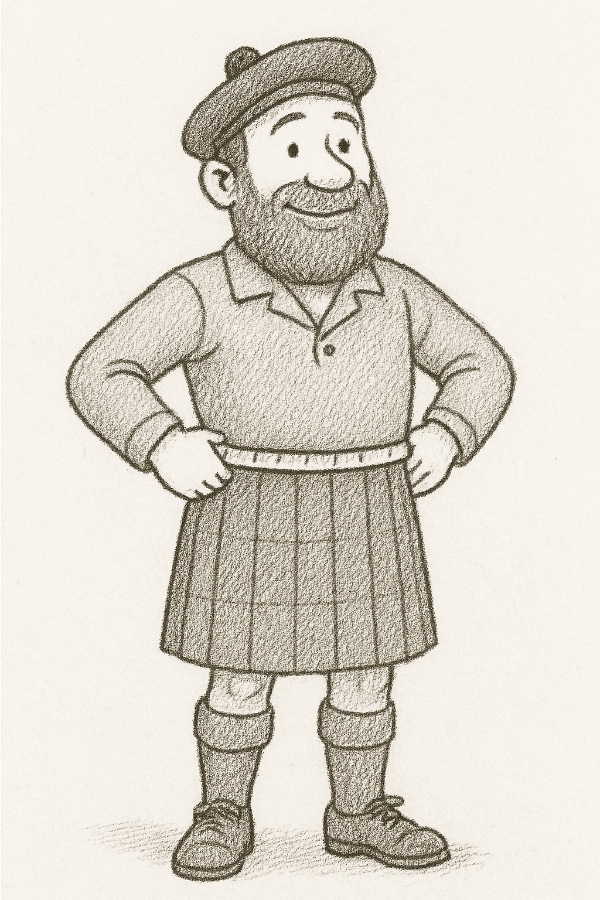How to Measure Yourself and Your Kilt for the Perfect Fit
A well-fitted kilt is one of the most flattering and comfortable garments you can wear – but getting the sizing right is crucial.
Whether you're ordering a new kilt, resizing an heirloom, or altering one that no longer fits, accurate measurements are the foundation of good kilt tailoring.
Unlike trousers or modern skirts, kilts sit higher on the body and follow traditional rules of fit. The goal is to achieve a clean, sharp line through the pleats, a balanced apron, and the correct length so that the tartan hangs gracefully from waist to knee.
In this guide, we'll walk you through the process of taking your own measurements – just as we would in our workshops in Glasgow and Edinburgh.
With the right tools and careful attention to detail, you'll be able to take reliable, professional-grade measurements to ensure your kilt fits as it should.
What You'll Need to Get Started
Before you begin measuring, make sure you have the following items to hand:
-
A soft tape measure (the flexible kind used in sewing)
-
A full-length mirror (if you're measuring yourself)
-
A friend or tailor to assist (recommended for accuracy)
-
Notepad or phone to record the numbers
-
A belt or string (to mark the natural waistline)
Wear light clothing or just underwear when measuring – bulky clothes can add inches and lead to a poor fit. If you have everything ready, you'll need the following measurements:
Taking the Waist Measurement
The waist on a traditional kilt sits higher than your trouser waist – typically around the natural waistline, which is the narrowest part of your torso, just below the ribcage and above the belly button.
It is therefore not possible to take your usual trouser waist size when measuring for kilt waist size.
Steps:
1. Stand straight, with your feet together on the floor and body relaxed.
2. Wrap the measuring tape around your natural waist to measure around. It should be snug but not tight.
3. Keep the tape level all the way around – use a mirror or helper to ensure it's not slipping lower at the back.
4. Take the measurement in inches, and note it down. This is your kilt waist size.
Tip: If you’re between sizes or your weight fluctuates, let us know – kilts can be adjusted slightly with clever tailoring or hidden extra material.

Taking the Length Measurement
The length of your kilt determines how it hangs and whether it looks traditionally proportioned. A proper kilt length should sit from your waist to the middle of your kneecap.
Steps:
1. Mark your natural waist using a belt or string.
2. Stand upright and measure from the waistline straight down the side of your leg to the centre of the kneecap (sometimes referred to as your mid knee).
3. Ensure you're standing tall with no bending or twisting – get help if possible.
4. Note the measurement in inches.
For military, pipe band or ceremonial kilts, the exact desired length may vary slightly – we can accommodate specific requests.
For further information on having your kilt re-sized professionally by our kilt doctors, please refer to:

Measuring the Seat – For a Comfortable and Balanced Fit
The seat measurement ensures your kilt hangs comfortably over the hips and the broadest part of your lower body. This is particularly important in heavy wool kilts, where a poor seat fit can cause fabric strain or flaring.
Steps:
-
Stand naturally with feet about shoulder-width apart.
-
Wrap the tape around the widest part of your hips and buttocks – usually 7–9 inches below the waistline.
-
Keep the tape measure snug but not tight. You should be able to fit one finger under the tape.
-
Record the measurement in inches.
Tip: The seat measurement isn’t used to cinch the kilt – it’s used to shape the pleated area so that it flows cleanly from the waist to the knees without pulling or gaping.
Understanding the Kilt Drop
The kilt drop is a specialist measurement sometimes used in military or pipe band tailoring, or when constructing a kilt for a tall person or someone with a long torso.
It’s the vertical distance between the waistline and the seat – helping the tailor plan where pleats should start to open out, and where the taper of the kilt should begin.
Steps:
-
Start at your natural waistline.
-
Measure vertically down to the widest part of your seat.
-
Record the drop in inches.
This is particularly useful for those with unique body proportions, ensuring the kilt remains flattering and well-shaped throughout the pleated section.
Considering Personal Preference
While there are traditional guidelines, kilt fit is also a matter of personal preference. Some people prefer a slightly longer kilt for modesty or style, while others like a military-cut look that sits just above the knee with a sharp edge.
When discussing your kilt alterations or custom tailoring with The Kilt Doctor, feel free to share:
-
How you like your kilt to sit (natural waist, slightly lower, etc.)
-
How much leg you prefer to show
-
If the kilt is for daily wear, formal events, or military/cultural use
We’ll use your measurements alongside your personal preference to create a fit that’s both authentic and comfortable.
The Feeling of a Perfectly Fitted Kilt
When your kilt fits just right, you’ll know it the moment you put it on.
The waistband should feel secure yet comfortable at your natural waist, not slipping down or cutting in. The pleats will fall cleanly and move with you, the apron will sit smoothly at the front without bulging or pulling, and the hem will finish neatly at the middle of your knee – offering the sharp, balanced look that’s been refined over centuries of traditional tailoring.
Whether you're wearing it to a wedding, a ceilidh, a military parade or simply to celebrate your heritage, a well-fitted kilt allows you to stand tall and feel proud. It doesn’t just fit your body – it fits your story.
At The Kilt Doctor, we believe every kilt should be worthy of the wearer. That’s why we take every measure – quite literally – to ensure your kilt looks and feels exactly as it should.
Ready to get started? Send us your measurements, and let’s get your kilt outfit looking its very best at the right size.
